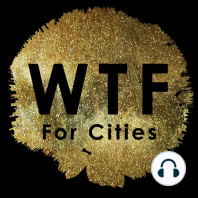13 min listen

193R_Transforming our cities: Best practices towards clean air and active transportation (research summary)
193R_Transforming our cities: Best practices towards clean air and active transportation (research summary)
ratings:
Length:
11 minutes
Released:
Feb 12, 2024
Format:
Podcast episode
Description
Are you interested in how to enhance urban air quality and active transportation?
Summary of the article titled Transforming our cities: Best practices towards clean air and active transportation from 2019 by Andrew Glazener and Haneen Khreis, published in the Current Environmental Health Reports journal.
This is a great preparation for our next interviewee, Oliver Stoltz in episode 194 talking about urban mobility changes.
Since we are investigating the future of cities, I thought it would be interesting to see how urban transportation and clean air are connected. This article explores effective strategies for enhancing urban air quality and encouraging active transportation like walking and cycling, highlighting the significant overlap between these two areas and the positive impacts of integrated policy approaches.
As the most important things, I would like to highlight 3 aspects:
In 2015, ambient air pollution, especially fine particulate matter (PM2.5), was the fifth-leading cause of death globally, causing 4.2 million premature deaths, mainly in low- and middle-income countries in Asia, Africa, and the Eastern Mediterranean, with older adults most vulnerable.
Motor vehicle reliance worsens air pollution and physical inactivity, linked to 3.2 million deaths yearly. Encouraging active transportation like walking and cycling could mitigate these risks.
Clean air and active transportation are interlinked, with shifting to active transportation not only improving air quality but also boosting physical activity, enhancing urban health.
You can find the article through this link.
Connecting episodes you might be interested in:
No.048 - Interview with Hussein Dia about urban transportation systems;
No.136R - An analysis of the legal framework influencing walking in Australia;
No.137R - Quantifying life quality as walkability on urban networks: the case of Budapest;
No.138 - Interview with Luis Natera about active transport in different cities;
You can find the transcript through this link.
What wast the most interesting part for you? What questions did arise for you? Let me know on Twitter @WTF4Cities or on the wtf4cities.com website where the shownotes are also available.
I hope this was an interesting episode for you and thanks for tuning in.
Music by Lesfm from Pixabay
Summary of the article titled Transforming our cities: Best practices towards clean air and active transportation from 2019 by Andrew Glazener and Haneen Khreis, published in the Current Environmental Health Reports journal.
This is a great preparation for our next interviewee, Oliver Stoltz in episode 194 talking about urban mobility changes.
Since we are investigating the future of cities, I thought it would be interesting to see how urban transportation and clean air are connected. This article explores effective strategies for enhancing urban air quality and encouraging active transportation like walking and cycling, highlighting the significant overlap between these two areas and the positive impacts of integrated policy approaches.
As the most important things, I would like to highlight 3 aspects:
In 2015, ambient air pollution, especially fine particulate matter (PM2.5), was the fifth-leading cause of death globally, causing 4.2 million premature deaths, mainly in low- and middle-income countries in Asia, Africa, and the Eastern Mediterranean, with older adults most vulnerable.
Motor vehicle reliance worsens air pollution and physical inactivity, linked to 3.2 million deaths yearly. Encouraging active transportation like walking and cycling could mitigate these risks.
Clean air and active transportation are interlinked, with shifting to active transportation not only improving air quality but also boosting physical activity, enhancing urban health.
You can find the article through this link.
Connecting episodes you might be interested in:
No.048 - Interview with Hussein Dia about urban transportation systems;
No.136R - An analysis of the legal framework influencing walking in Australia;
No.137R - Quantifying life quality as walkability on urban networks: the case of Budapest;
No.138 - Interview with Luis Natera about active transport in different cities;
You can find the transcript through this link.
What wast the most interesting part for you? What questions did arise for you? Let me know on Twitter @WTF4Cities or on the wtf4cities.com website where the shownotes are also available.
I hope this was an interesting episode for you and thanks for tuning in.
Music by Lesfm from Pixabay
Released:
Feb 12, 2024
Format:
Podcast episode
Titles in the series (100)
017R_On the difficulty of agreeing upon a universal logic for city standards - A response to Schindler and Marvin (research summary) by What is The Future for Cities?